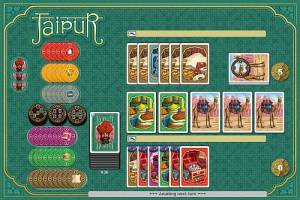A few years ago there seemed to be a flurry of dice based “express” versions of boardgames, mainly unofficial fan based, on BoardgameGeek and since then there seems to have been a few official ones (maybe the publishers/designers were watching 🙂 ). I have just got hold of Zooloretto Dice, or Zooloretto Würfelspiel to give its proper name, for its only out in German so far.
Zooloretto was a tile laying game developed from Coloretto a card based game and did have quite a few improvements in game play. I believe Zooloretto was a bigger success especially as it seems to have spawned several expansions. So what do you get with Zoo-Dice and is it simply a dice implementation of the game?
The game comes in a small box, so easy to pack in a bag when going anywhere, and contains ten D6 dice, a small board and a pad of score sheets:
- The dice are all identical with five animal types and a gold coin, you are using the dice instead of tiles
- The board is double sided and depicts the carts where you place the dice (which side you use depends on how many are playing)
- The pad of score sheets depicts the zoo and each player gets one.
I shall give a quick overview of playing the game and compare it to Zooloretto (or Zool for shorthand). On a turn a player may roll two dice and add them to the carts, or take the dice from one cart into their enclosure. This is similar to what you do in Zool though there are subtle differences. For a start as you are rolling dice the probability of what you get remains the same, where as when drawing tiles with Zool you can count how many of each type has been out. Another difference is in the carts, where as with Zool once a cart has been claimed it is out for that round, in Zoo-Dice the now empty cart is available to be refilled, which adds options especially in the 4 player game.
When you add dice to your enclosures you mark them off on your sheet, you can only hold a set number of each type and any excess go in your barn to score negative points. So you can’t swap animal enclosures like in Zool, nor buy from other players barns. You score a point for each animal in your enclosures and -2 for each type in your barn. In addition there are bonus points for each animal type to the player who filled it first (other players who then fill don’t get the bonus), which can mean watching what animals other players are collecting to see who can fill them first. The coins are just collected, you get a point for the first 3, another for next 2, and a 3rd for the 6th – collecting coins after this are wasted. Unlike Zool the coins are not used to buy things, however at the game end you can decide whether each set of coins you have score or are used to remove one type of animal from your barn (so +1 or remove a -2). The game ends the round where one player either fills all their animal enclosures or only has one type unfilled.
So how does it compare? It is a shorter game, but I think it is quite a good development. The re-use of carts does mean it is possible to avoid taking an unwanted animal if you manage to tempt an opponent to take a cart before all the dice are out and only awarding the full enclosure to the player who first fills that type does mean its less of a multiplayer solo as you are watching what others are filling. In Zool it isn’t always clear who is winning until the end is counted, but its easier to see in Zoo-Dice.

 Another of Tom’s games is
Another of Tom’s games is 




